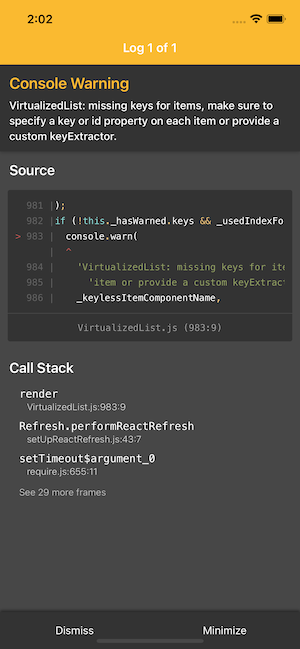By Aman Mittal
In React Native, you can use the FlatList component to render a long list of data. It renders only the items shown on the screen in a scrolling list and not all the data at once.
To render a scrollable list of items using FlatList, you need to pass the required data prop to the component. The data prop accepts an array of items. Each item in the array represents a single item in the list.
Another required prop is renderItem, which takes an item from the data and renders it on the list. This prop accepts a function that returns the JSX to be rendered.
To display an item in the scrollable list, the FlatList component requires that each item has a unique key such as an id. This key is what allows the FlatList component (since it uses VirtualizedList under the hood) to track the order of items in the list.
The key from the data array is extracted using the keyExtractor prop on the FlatList component.
In this post, let's talk about where you might need to use keyExtractor and in what scenarios it's not required.
How to Display a List of Items Using FlatList
Consider the following structure of data. There are ten items in the array, and each item has two properties, id and title. The id is the unique key for each item.
const DATA_WITH_ID = [
{
id: 1,
title: 'quidem molestiae enim'
},
{
id: 2,
title: 'sunt qui excepturi placeat culpa'
},
{
id: 3,
title: 'omnis laborum odio'
},
{
id: 4,
title: 'non esse culpa molestiae omnis sed optio'
},
{
id: 5,
title: 'eaque aut omnis a'
},
{
id: 6,
title: 'natus impedit quibusdam illo est'
},
{
id: 7,
title: 'quibusdam autem aliquid et et quia'
},
{
id: 8,
title: 'qui fuga est a eum'
},
{
id: 9,
title: 'saepe unde necessitatibus rem'
},
{
id: 10,
title: 'distinctio laborum qui'
}
];
Using the FlatList component, you want to render the title of each item as shown below:
export default function App() {
const renderList = ({ item }) => {
return (
<View style={styles.listItem}>
<Text style={styles.listItemText}>{item.title}</Text>
</View>
);
};
return (
<View style={styles.container}>
<FlatList data={DATA_WITH_ID} renderItem={renderList} />
</View>
);
}
The result of the above component will display a list of items without any errors or warnings. In addition, the FlatList component doesn't require a unique key to identify each item since the original data structure already contains a key called id.
Here is the output on a device's screen from the above snippet:

How to Use the keyExtractor Prop
By default, the keyExtractor prop checks for properties like key and id (in that order). If either of the two is present in the original data structure, it will be considered a unique key by the FlatList component.
In this case (as in the previous example), you do not have to explicitly use the keyExtractor prop.
If neither of them are provided, the FlatList component will throw a warning "VirtualizedList: missing keys for items ...":

Now, let's consider a scenario where an array of data contains a unique key with each list item but the name of the unique key is neither key nor id. It contains a unique key property with the name of userId.
const DATA_WITH_USER_ID = [
{
userId: 1,
title: 'quidem molestiae enim'
},
{
userId: 2,
title: 'sunt qui excepturi placeat culpa'
},
{
userId: 3,
title: 'omnis laborum odio'
},
{
userId: 4,
title: 'non esse culpa molestiae omnis sed optio'
},
{
userId: 5,
title: 'eaque aut omnis a'
},
{
userId: 6,
title: 'natus impedit quibusdam illo est'
},
{
userId: 7,
title: 'quibusdam autem aliquid et et quia'
},
{
userId: 8,
title: 'qui fuga est a eum'
},
{
userId: 9,
title: 'saepe unde necessitatibus rem'
},
{
userId: 10,
title: 'distinctio laborum qui'
}
];
When rendering the list, you will see the warning in this case because the FlatList component doesn't recognize the userId as the key or id name in the original data structure.
For custom key names such as userId in the example above, you'll use the keyExtractor prop. It extracts the unique key name and its value and tells the FlatList component to track the items based on that value.
For the above array of data, modify the FlatList component and use the keyExtractor prop to extract the key:
<FlatList
data={DATA_WITH_ID}
renderItem={renderList}
keyExtractor={item => item.userId}
/>
The warning will then disappear after this step.
Conclusion
When using a FlatList component, if the data array has a unique id or a key property, you do not need to use the keyExtractor prop explicitly. But for custom id names, use the keyExtractor prop to explicitly tell the component which unique key to extract.
If you'd like to learn more about React Native, check out the React Native category and Expo category pages on my blog. You can also subscribe my newsletter or follow me on Twitter to get updates on whenever I publish a new article or tutorial.
